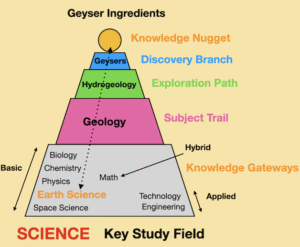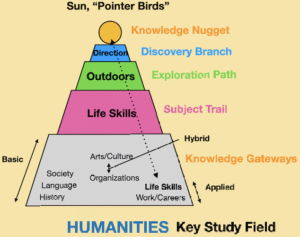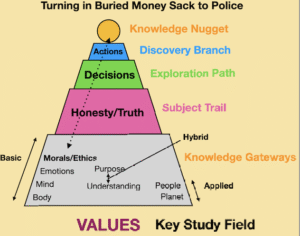Parent’s Guide to BioFables Books
We are updating the original system of resources; we hope you find them to be more intuitive and user-friendly. Thanks for your patience and understanding.
INTRODUCTION. For a quick look at all the BioFables books published so far, please click on the Series 1 Book List tab at the top of each page or click here. Click on any book’s cover image to go directly to that book’s own home page on this site. Each book has two dedicated pages:
-
-
- Home page: a brief excert from the book and a link to its Knowledge Gateways page;
- Knowledge Gateways page: sets of lists and tables of each book’s 100 or so pop-up mini lessons (Knowledge Nuggets) into five major categories, from the MOST GENERAL to the MOST SPECIFIC.
-
There is a very good reason for using this traditional structure. Think of a grocery store. Even the smallest store carries about 2,000 products, whereas “big box” stores can offer 60,000 or more products. Big signs over the GENERAL sections (such as meat department, bakery, canned goods, fresh produce) point you to the products you want to buy. You head directly to the store’s FRESH PRODUCE section, where you browse among the carrots. They’re organized according to whether they are loose, packaged, organic (among other categories). You know the specific items you’re looking for and the store’s organization helps you find them. Another example is the library classification by general and then more-detailed subject.
In learning something new, however, children and adults tend to remember the most specific information they’ve discovered. Where that specific information fits in the general scheme of thngs comes later. That’s why you’ll first encounter colorful pyramics on this page that turn the traditional general -> specific model upside down. Then you’ll see how tables present the same information more compactly.
PYRAMIDS: You can trace a Knowledge Nugget lesson all the way to its roots in one of BioFables’ three major Key Study Fields (Science, Humanities, or Values). It’s also a simple way to discover other fascinating lessons.

-
-
- Knowledge Nugget: a specific pop-up mini-lesson
-
- Discovery Branch: the general group that has several or many other Knowledge Nugget lessons
- Exploration Path: a specific category of the Discovery Branch
- Subject Trail: ONE of the major subjects within the Key Study Field
-
-
-
-
-
-
-
-
-
-
- Knowledge Gateways: the 7 or 8 major subjects that are part of each of 3 Key Study Fields (Science, Humanities or Values)
-
-
-
-
-
-
-
-
-
-
- Discovery Branch: the general group that has several or many other Knowledge Nugget lessons
-
- Knowledge Nugget: a specific pop-up mini-lesson
-
Why did we use the same orange color and the word “Knowledge” for both the Nuggets and the Gateways? Your children will think of the Knowledge Nuggets they encounter as fun things to know, and the Knowledge Gateways as entrances to a whole world of learning. They’ll learn that subjects typically fit into basic, hybrid and applied categories (see the arrows at the bottom of the pyramid). Basic subjects are core, fundamental or theoretical studies, Applied are subjects that put the core subjects to practical use, and hybrid subjects that are used in both basic and applied subjects.
The three pyramds below show examples of how you can find the source of a specific Knowledge Nugget all the way to its Key Study Field. Just follow the dotted lines. Following each pyramid is a section of the Knowledge Gateway table showing the specific row as it appears in its Knowledge Gateways page.
Science Key Study Field
 Do you know how many different ingredients it takes to make a geyser? (You’ll find the answer and a drawing that 7-year-old Mallory made of his “teapot geyser” on Page 26 of BioFables’ first book: Whoosh; Old Faithful Uncovers a Mystery).
Do you know how many different ingredients it takes to make a geyser? (You’ll find the answer and a drawing that 7-year-old Mallory made of his “teapot geyser” on Page 26 of BioFables’ first book: Whoosh; Old Faithful Uncovers a Mystery).

The next two pyramids are examples of the other two basic study fields of Humanities and Values. They follow the same design as the Science Key Study Field.
A Word About How Humanities and Values Differ from the Science Key Study Field. The term Science is generally understood to mean “Natural” Science, or the study of the physical world, including the universe. Science categories are very well established and there is general agreement regarding specific terms.
The terms Social Science and Political Science, on the other hand, belong to Humanities, the second of our three Key Study Fields. There is less general agreement on the words or phrases used in naming the categories or groups in the Humanities, and even less agreement in the Values, categories.
This is okay, though. Many people tend to see multiple naming or even relationship options for any specific topic in these two Key Study Fields. Those students who see different options than used here are exercising judgment, a good sign of their growing maturity.
Humanities Key Study Field

Grandpa teaches Melody and her 7-year-old twin brother Mallory how the Sun and “Pointer Birds” help find their way through a maze. You can use the sun to tell the compass direction (without using a compass). “Pointer Birds” will let you know where a food source, such as a picnic area, might be.
Pumpkins, Mazes and…Grandpa’s Big Surprise, (Book 7) offers some hints on important life skills, not to mention Grandpa’s Big Surprise.

Mallory discovers something buried in a “living” sand dune. Rufus, the family’s black Labrador, helps to dig it up. When Mallory’s Dad comes over to see what’s happening, he has a pretty good idea of what it is. Sure enough, it’s a money sack.
All sorts of thoughts run through Dad’s mind, but his finer instincts win out. “We need to report this,” he tells Mal, and they drive to the local police station. Find out more in Books 3 and 4 (Sand Sack and Palisades Excapades).
